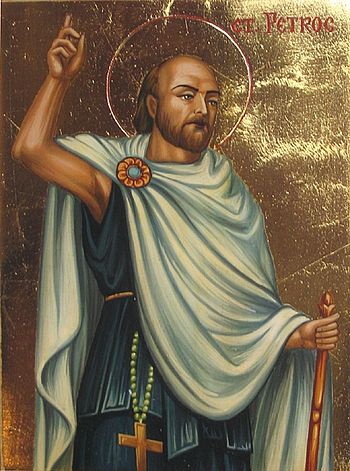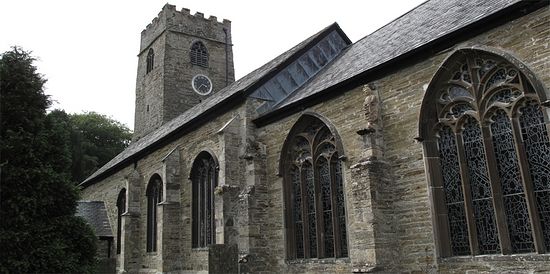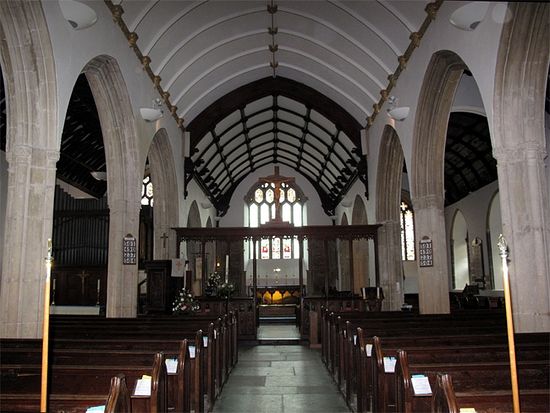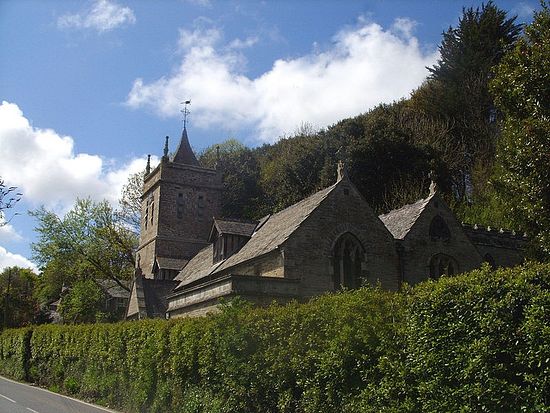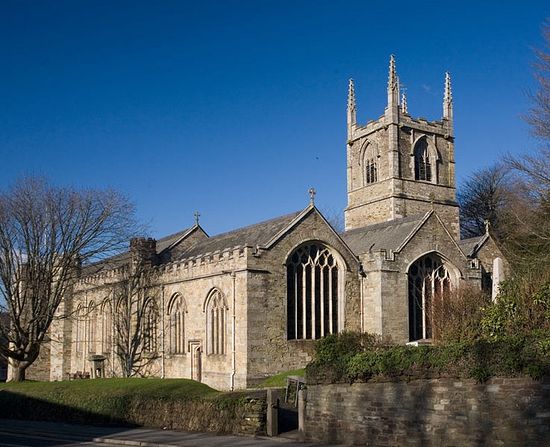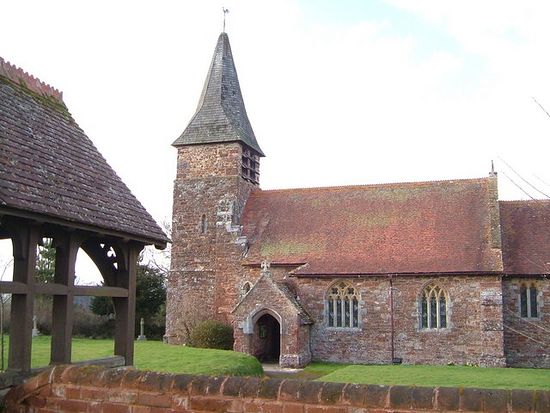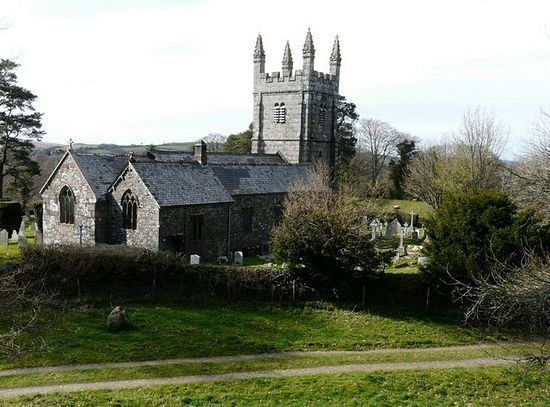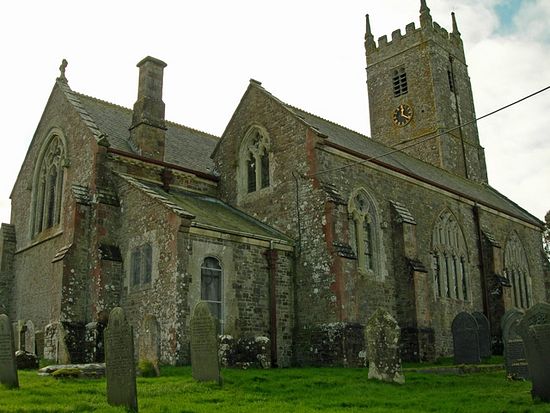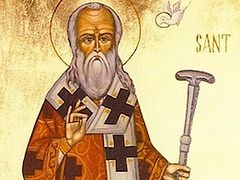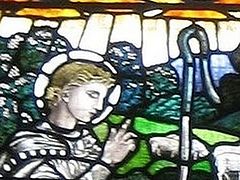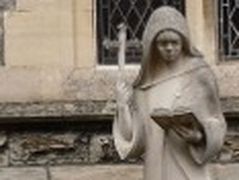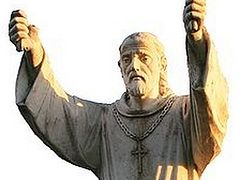Cornwall, the peninsula in the south-west of England and now one of 48 ceremonial English counties, was in ancient times a part of the kingdom of Dumnonia, which comprised territories of the present-day counties of Cornwall, Devon and part of Somerset and Dorset. The Gospel was brought to Cornwall in the fifth century or even earlier, and monastic life began there in 475. At that time Cornwall became known as “the land of saints” or “the Thebaid of saints”. Indeed, between the fifth and seventh centuries Cornwall produced so many saints, ascetics, hermits, abbots, missionaries, holy bishops and kings, that nearly each town and village in the region has its own patron-saint.
Christian life and the monastic tradition of Cornwall were similar to those of Wales and Brittany and many ascetic customs were indeed derived from the desert fathers of Egypt, the “Thebaid”, and Syria. Unfortunately, the lives of many ancient Cornish saints were lost at the Norman Conquest or else after the Reformation. And today, though veneration for them continues and many churches and holy wells are dedicated to them, we can say very little about most of these saints. The most venerated saint in Cornwall, who is considered to be one of the main enlighteners of Dumnonia, is St. Petroc (Petrock/Peter), who together with the Archangel Michael and St. Piran, has for many years been the patron-saint of Cornwall. Though two later medieval versions of his life are not very reliable, they are mainly based on ancient traditions, so we can outline the major events and activities of his life.
St. Petroc was probably born in the second half of the fifth century in south Wales and was a son of king Glywys of Glywysing (now Glamorgan). After the death of his father, St. Petroc firmly refused to share power with his brothers and decided to dedicate all his life to the service of God. The saint went to study in Ireland together with several companions, where, according to some sources, he spent about 20 years. In Ireland St. Petroc became so experienced that he himself instructed the future saint Kevin of Glendalough. From Ireland St. Petroc then sailed to Cornwall where he was very active as a missionary. He first settled at the mouth of the River Camel at a place called Trebetherick and soon founded nearby the monastery of Padstow which was to become the most famous in Cornwall.
The original name of Padstow is Lanwethinoc, because an ascetic named Wethinoc had lived there before Petroc. After St. Petroc’s death the place was for a long time known as Petrocstowe, i.e. “St. Petroc’s place”. With the help of local people Petroc developed this originally modest church into a large monastery with a school, infirmary, library, a farm and many cells for brethren. After 30 years of unceasing labours for the glory of God in Padstow, St. Petroc founded another monastic centre with a chapel and mill at Little Petherick just a few miles south of his first monastery, originally amid dense woods. More and more local residents came to love Petroc and on listening to his sermons numerous pagans embraced Christianity. Such was the zeal of the venerable father that he even converted King Constantine of Cornwall to Christ. The latter, who had an unholy life before then, himself became a zealous preacher and, according to tradition, later abdicated and undertook missionary work in Scotland, where he eventually became a martyr.
After some time at Little Petherick, it is said that St. Petroc made a pilgrimage to Rome, then to the Holy Land, and, according to many sources, even spent seven years on an island in the Indian Ocean! There is strong evidence that St. Petroc visited Brittany more than once; there he preached, and dozens of places bear his name and numerous churches are dedicated to him there to this day. After returning to Cornwall, Petroc lived for a long while as a hermit on the granite moorland of Bodmin Moor, devoting all his time to prayer. Once another ascetic, St. Goran, visited him there. Petroc built a cell on the river bank for himself and on the top of the hill nearby he later built a monastery for his 12 disciples (it should be said that the site was chosen very wisely, with running water, a pool, streams, fertile land and a valley nearby). With time the number of disciples increased; they followed their spiritual father everywhere and tried to follow his example in monastic life.
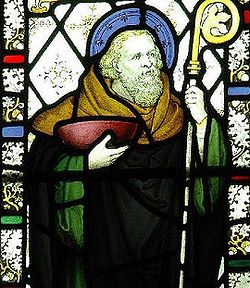 An image of St. Petroc at the Bodmin Church
An image of St. Petroc at the Bodmin Church
An early manuscript describes Petroc as “handsome, courteous in speech, prudent, modest, burning with unceasing love, always ready for all good works for the Church.” St. Petroc often visited the monasteries and churches that he had founded, being an exemplary and tireless pastor despite his extremely old age. The holy Abbot Petroc reposed during one such journey at a place called Treravel. This took place either in c. 564 or in c. 594. The venerable abbot was buried at Padstow, which became the main centre for his veneration. Due to the activity of his disciples veneration for Petroc grew. St. Petroc’s church, dating back to the thirteenth – fourteenth centuries, stands on the site of his monastery in Padstow to this day.
Among the relics there are the top portion of a Celtic cross and the base of a large ancient cross. In 981, the Monastery of Padstow was ravaged by the Vikings and the monks had to move to Bodmin (then “Bodmine”), taking the precious relics of their patron-saint with them. From then on Bodmin became the second most important centre for his veneration. Later it even became a diocese, and the major town of Cornwall. Today Bodmin is situated in central Cornwall, its name meaning “a dwelling of monks”. It was here that St. Petroc founded the monastery, which was the daughter community to Padstow. The monastery continued to exist after the Norman Conquest.
Today Bodmin is still a great centre of pilgrimage: its former Abbey Church of St. Petroc, rebuilt in Norman times and again largely reconstructed in the fifteenth century, still stands and welcomes pilgrims. It is the largest parish church in the whole of Cornwall (151 feet long and 65 feet wide) and the largest church building after Truro Cathedral. After the translation of the relics of St. Petroc together with his staff and bell (a feature common to many Celtic saints) to Bodmin, they were greatly venerated by countless pilgrims until the Reformation. In 1177 a priest named Martin suddenly stole the relics and brought them to the monastery of Saint-Meen in Brittany. The Bishop of Exeter immediately reported the theft to King Henry II. The King intervened and the relics were solemnly returned to Bodmin, though one of the saint’s ribs remained in Brittany.
 St. Petroc's reliquary inside the Bodmin Church
St. Petroc's reliquary inside the Bodmin Church
Walter of Coutances, the future Bishop of Rouen, donated a beautiful and splendid ivory reliquary to Bodmin for keeping the relics of St. Petroc. At the Reformation the relics of St. Petroc disappeared (they were probably buried in a safe place) while his reliquary was for a while lost. But in the nineteenth century this unique shrine was discovered absolutely safe near Bodmin church, and it has been displayed inside this church as a great symbol of Cornwall to this day. Surprisingly, this splendid relic was again temporarily lost in 1994, being stolen by a vandal. At that time all believers of Cornwall were encouraged to pray, the incident was reported to the Queen, and thanks to efforts of the police the reliquary was miraculously found safe in a field of Yorkshire in the north of England.
There is still a holy well in the churchyard of Bodmin church, associated with another saint, St. Guron, a contemporary of Petroc who had lived here in a cell before the saint’s arrival and then moved to a spot called Gorran.1 There are also some monastic ruins close to the church, and the splendid holy well of St. Petroc is located in Priory Park. In medieval times, monks of Bodmin produced two famous “Gospels of Bodmin” which are now both kept at the British Museum. In the Cornish village of Little-Petherick, where Petroc founded a monastery, there is a medieval church dedicated to him. The only Somerset church of St. Petroc is situated in the village of Timberscombe. Among important historic churches dedicated to Petroc we can mention churches in Petrockstow (seventh – eighth century), Lydford, Newton St. Petrock, Dartmouth, Inwardleigh, Farringdon, Hartford, Parracombe (all in Devon), Llanbedrog on the Llyn peninsula (Gwynedd, Wales), St. Petrox (Pembrokeshire, Wales) and Egloshayle (Cornwall).
In the late twentieth century, an Orthodox monastery was dedicated to St. Petroc in Tasmania. The saint is much venerated in Cornwall, Devon, Wales, Brittany; and in the medieval period veneration for him even extended to York, Bury and Ely. A number of settlements of former Dumnonia still bear the name of St. Petroc—for example Petrockstowe and Newton St. Petrock (Devon). Moreover, the official flag of the county of Devon has since 2006 been called, “St. Petroc’s flag”.
Holy Father Petroc, pray to God for us!


